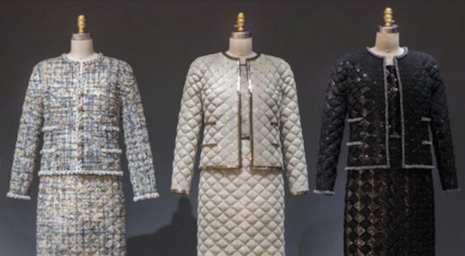- About
- Subscribe Now
- New York,
July 10, 2017

 Chanel's jacket made with 3D printing. Image credit: Fashionbi
Chanel's jacket made with 3D printing. Image credit: Fashionbi
As 3D printing becomes more prominent in manufacturing, the process is now making an impact on fashion and accessories.
A new report from Fashionbi shows that the Additive Manufacturing industry, 3D printing, has seen a compound annual growth rate increase of 25.9 percent the past year. The manufacturing process is bringing innovation to fashion design with new designers coming on the scene with 3D printed accessories and apparel.
“We were surprised to discover that the 3D printing technology is already used to create product from all possible market segments, starting from prototyping to the production of the ready to sell items,” said Yana Bushmeleva, chief operating officer at Fashionbi, Milan. “In the eyewear segment, we can mention Safilo that makes 3D printed eyewear prototypes of frames for their own brands and their clients with a possibility to combine a near endless gamut of 360,000 striking colors.
“Adidas created Futurecraft 3D sneakers at the state-of-the-art - SpeedFactory in Germany with integrated ARAMIS technology, which has been used to understand the exact motions of an athlete's foot while running,” she said. “A new torsion bar for greater flexibility, along with their standard BOOST technology and PRIMEKNIT.”
“Baunat brand is printing exclusive text jewelry necklaces in 18-karat white, yellow or rose gold with small diamonds of high quality.”
Impression on fashion
The opportunities for 3D printing are becoming more apparent as the technology becomes easier to harness, and the fashion industry is no exception.
Fashionbi’s report on 3D Printing in Fashion and Textiles detailed how Karl Lagerfeld looked to leverage the technology at French atelier Chanel. While the luxury fashion industry traditionally prides itself on the craftsmanship and handiwork that goes into creating a garment or leather good, it may be starting to warm to the idea of using 3D printing in its production.
At Chanel’s haute couture show in 2015, some of the tweed pieces that were modeled on the runway were created using 3D printing. Having one of the biggest names in high-fashion embrace the technology may open the doors for expanded use of 3D printing among luxury labels, which has the possibility of altering the definition and positioning of luxury (see more).
The fashion show included a series of its iconic jacket, made with a 3D printer.
Home décor designer Odo Fioravanti has created a line of clutches that are made with 3D printing as well. The bags are made with nylon, PLA, steel and brass dyed with Nylon, but remain lightweight.
Consumers can purchase the product for $630 online.
3D printed clutches from Odo Fioravanti. Image credit: Fashionbi
Shapeways is an online manufacturer that allows users to sell and purchase 3D printed accessories, which it will print for them. Shoppers can upload their own designs for purchase or choose one from the designer.
The online company has a network of users that consists of more than 520,000 individuals a month. Fashionbi notes that 44 percent of those users come from the United States.
Manufacturing fashion
Italy’s Safilo also embraced 3D printing technologies to produce the prototypes of its eyewear frames in record time.
Safilo is the eyewear licensor of a number of high-fashion brands including Hugo Boss, Jimmy Choo, Christian Dior and Max Mara, among many others. By having the ability to quickly create 3D-printed models of potential eyewear designs, Safilo-licensed brands will be able to send new frames to market at a higher rate, a significant benefit due to the popularity of the eyewear category (see more).
Jimmy Choo's Vivy sunglasses are licensed by Safilo
“There are several types of 3D printing technologies that are being used worldwide and the 3D technology has established itself mostly in the segments of accessories,” Fashionbi's Ms. Bushmeleva said.
“The 3D printing gives an ability to develop concepts and ideas faster than ever, allows mass customization of products, eliminates inventories and unsustainable logistics for shipping the prototypes between producer and client and maintain wastage control better than the traditional approaches," she said.
Share your thoughts. Click here